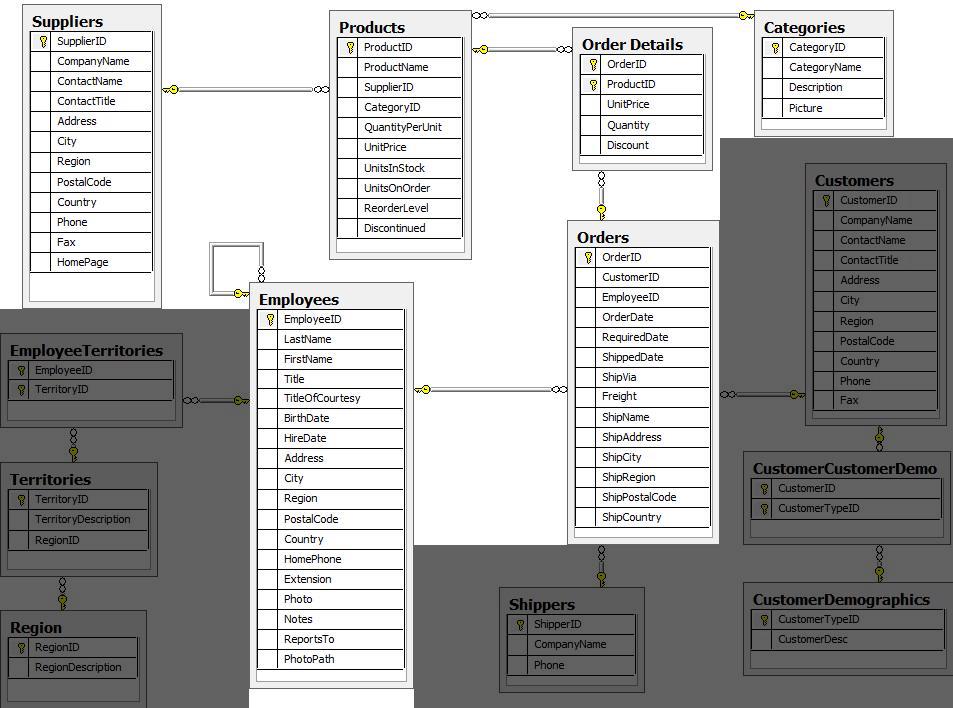Quick Start
Note
This is a quick start guide for the library. For more details, please checkout the full documentation.
As a first example, we will convert the Northwind Traders dataset into a Neo4j graph. The complete example code can be found here. The official Neo4j documentation has a tutorial on how to import the Northwind Traders dataset using direct import with CYPHER. We will use the same dataset, but instead of using CYPHER, we will use the Data2Neo library to convert the data into a graph.
Data2Neo decomposes the data integration process into three distinct parts:
Resource Abstraction: We encapsulate each relational entity in a
Resource, with eachResourcepossessing a type corresponding to, for example, its table name. AResourceIteratoris employed to iterate over all Resources to be converted. This abstraction provides us with the flexibility to accommodate various data sources. Data2Neo currently has pre-implemented iterators for SQLite databases and pandas Dataframes.Conversion Schema: The Convertion Schema outlines how each Resource type should be managed, effectively serving as a blueprint for integrating each Resource type.
Converter: The
Convertertakes data from theResourceIteratorand integrates it into an existing knowledge graph, based on the specifications provided in the Convertion Schema.
Example “Northwind”
The Northwind Traders dataset depicts a product sale system. Most importantly it contains the tables Suppliers, Products, Categories, Employees and Orders.

In order to more naturally represent the relationships between these entities, we want to convert the data into a graph that looks like the following:

We are now going to write the Convertion Schema for this conversion. The schema is written in a YAML style config file. In this config file we specify, which entities are to be converted into which nodes and which relationships.
For now, let us focus on the Orders table. For each order we want to create a node with the label Order and the attributes orderID and shipName.
We also want to create a CONTAINS relationship between the order node and the Product node, which is linked to the Order through the ProductID.
The relationship should have the attributes unitPrice and quantity. The order node also needs to be connected to an Employee node with a SOLD relationship. The schema for this conversion is shown below:
ENTITY("Orders"):
NODE("Order") order:
+ orderID = INT(orders.OrderID)
- shipName = orders.ShipName
RELATIONSHIP(order, "CONTAINS", MATCH("Product", productID=orders.ProductID)):
- unitPrice = FLOAT(orders.UnitPrice)
- quantity = FLOAT(orders.Quantity)
RELATIONSHIP(MATCH("Employee", employeeID = Orders.EmployeeID), "SOLD", order):
Refer to the conversion schema chapter for more details on the syntax. The full schema for all tables can be found here. If performance is an issue, refer to the performance chapter for more details on how to optimize the schema.
Note that we have used the keywords FLOAT and INT in the schema. These are so called wrappers. Wrappers can be used to insert arbitrary Python code into the conversion process, in this case to convert the data to the correct datatype.
Fortunatly, the library comes with a set of pre-implemented wrappers. To use the INT and FLOAT wrappers we simply need to import import data2neo.common_modules.types.
We can also define our Python functions and register them with Data2Neo. As an example, let’s consider a scenario where the UnitPrice column in the Orders table contains values in different currencies. We can define a function, CONVERTCURRENCY, to standardise these values into a single currency, register it, and then use it in the conversion schema. Read more about wrappers here.
from Data2Neo import register_attribute_postprocessor, Attribute
@register_attribute_postprocessor
def CONVERTCURRENCY(attribute, currency):
if currency == "USD":
# convert to USD
new_value = ...
elif
...
return Attribute(attribute.key, new_value)
""" Now you can use the CONVERTCURRENCY function in the conversion schema
RELATION(order, "CONTAINS", MATCH("Product", productID=orders.ProductID)):
- unitPrice = CONVERTCURRENCY(FLOAT(orders.UnitPrice), "USD")
- quantity = FLOAT(orders.Quantity)
"""
Finally, we need to create a ResourceIterator that iterates over the data in the Northwind database.
We will use the PandasDataFrameIterator from data2neo.relational_modules.pandas. We will also use the IteratorIterator, which can wrap multiple iterators to handle multiple dataframes.
Since pandas DataFrames have no types/table names associated with it, we need to specify the name when creating a PandasDataFrameIterator.
The Python code looks like this:
import neo4j
import pandas as pd
from tqdm.notebook import tqdm
from data2neo.relational_modules.pandas import PandasDataFrameIterator
from data2neo import IteratorIterator
from data2neo import Converter
from data2neo.utils import load_file
import data2neo.common_modules.types # For FLOAT, INT, etc. wrappers
# This is required because the pandas dataframe iterator will convert all values
# to int64 which is not supported by neo4j
uri = "bolt://localhost:7687"
auth = neo4j.basic_auth("neo4j", "password") # CHANGE TO YOUR CREDENTIALS
# Create IteratorIterator
files = ["categories", "employees", "orders", "products", "suppliers"]
iterators = []
for file in files:
df = pd.read_csv(f"https://raw.githubusercontent.com/neo4j-documentation/developer-resources/gh-pages/data/northwind/{file}.csv")
# The DataFrameIterator takes two arguments: the dataframe and the name of the table
iterators.append(PandasDataFrameIterator(df, file))
# The IteratorIterator takes a list of iterators and iterates over them sequentially
iterator = IteratorIterator(iterators)
# Create converter instance with schema, the final iterator and the graph
# We assume the schema is stored in a file called schema.yaml
converter = Converter(load_file("schema.yaml"), iterator, uri, auth, num_workers = 5)
# Start the conversion
converter(progress_bar=tqdm)